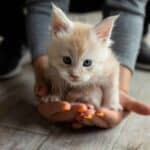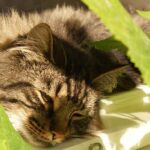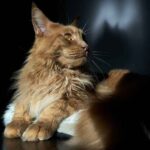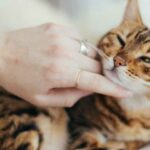If you start to raise a Maine Coon kitten, or you are thinking about getting one, you might be wondering how big your cat will grow and what to expect from its development stages.
Maine Coons are one of the largest and most majestic cat breeds, with a unique appearance and personality.
However, Maine Coons are not born big. They have a slow and long growth rate, which means they take longer to reach their full size and maturity than most other cat breeds.
They also have different nutritional and health needs, depending on their age and size.
In this post, I will share some facts and tips about Maine Coon kitten development stages, from birth to adulthood.
I will also answer some common questions about Maine Coon size, such as how big they will grow, what influences their size, how to tell if they are overweight, and when they will stop growing.
How Big Will Maine Coon Cats Grow?
The first thing you might want to know is how big your Maine Coon cat will get when fully grown.
The answer: It depends.
There is no definitive answer to this question, because Maine Coon size can vary greatly depending on several factors, such as genetics, gender, nutrition, environment, and health.
However, some general averages and ranges can give you an idea of what to expect.
According to the Cat Fanciers’ Association (CFA), the official breed standard for Maine Coons states that males should weigh between 15 and 25 pounds (6.8 and 11.3 kg), while females should weigh between 10 and 15 pounds (4.5 and 6.8 kg).
However, these are only guidelines, and some Maine Coons can be smaller or larger than these weights.
Another way to measure Maine Coon size is by their length and height.
The length is measured from the tip of the nose to the tip of the tail, while the height is measured from the shoulder to the ground.
The average length of a Maine Coon is between 19 and 32 inches (48 and 81 cm), while the average height is between 10 and 16 inches (25 and 40 cm).
Again, these are only averages, and some Maine Coons can be shorter or longer than these measurements.
The Guinness World Records recognizes the longest domestic cat in history as a Maine Coon named Stewie, who measured 48.5 inches (123 cm) in length.
The current record holder for the longest living domestic cat is also a Maine Coon named Barivel, who measures 47 inches (120 cm) in length.
These are exceptional cases, though, and most Maine Coons will not reach these sizes.
Maine Coon Kitten Development Stages Week By Week
Now that you have an idea of how big your Maine Coon cat will grow, let’s take a look at how they will grow from kitten to adult.
Maine Coon kittens go through various development stages, each with its own characteristics and milestones. Here is a summary of the main stages:
| Stage | Weight |
|---|---|
| Birth – 1 Week | 0.3 and 0.6 pounds (100 and 200 g) |
| 2 – 3 Week | 0.6 and 1.3 pounds (200 and 500 g) |
| 4 – 7 Week | 1.2 and 2.6 pounds (500 and 1000 g) |
| 8 – 12 Weeks | 2.2 and 4.4 pounds (1000 and 2000 g) |
| 13 – 24 Weeks | 4.4 and 8.8 pounds (2000 and 4000 g) |
| 25 – 52 Weeks | 8.8 and 15.4 pounds (4000 and 7000 g) |
| 1 – 4 Years | 10 and 25 pounds (4500 and 11300 g) |
Birth to 1 week: 0.3 and 0.6 pounds
This is the neonatal stage, where kittens depend entirely on their mother for survival.
They are born blind, deaf, and toothless, and they spend most of their time sleeping and nursing.
They weigh between 0.3 and 0.6 pounds (100 and 200 g) at birth.
2 to 3 weeks: 0.6 and 1.3 pounds
This is the transitional stage, where kittens start to open their eyes and ears, develop their senses, and explore their surroundings.
They also begin to crawl, stand, walk, play, groom themselves, and use the litter box. They weigh between 0.6 and 1.3 pounds (200 and 500 g) at this stage.
4 to 7 weeks: 1.2 and 2.6 pounds
This is the socialization stage, where kittens learn social skills from their mother and siblings, such as communication, body language, manners, boundaries, and hunting.
They also become more active, curious, confident, and independent.
At this stage, they weigh between 1.2 and 2.6 pounds (500 and 1000 g).
8 to 12 weeks: 2.2 and 4.4 pounds
This is the juvenile stage, where kittens reach their peak physical development and activity level.
They also develop their personality traits and preferences.
This is the ideal time to adopt a kitten or introduce it to a new home, as they are ready to bond with their new family and adapt to their new environment.
They weigh between 2.2 and 4.4 pounds (1000 and 2000 g) at this stage.
13 to 24 weeks: 4.4 and 8.8 pounds
This is the adolescent stage, where kittens go through puberty and experience hormonal changes.
They also become more territorial, assertive, and adventurous.
They may display some unwanted behaviors, such as spraying, scratching, biting, or fighting, which can be prevented or corrected with proper training and socialization.
They weigh between 4.4 and 8.8 pounds (2000 and 4000 g) at this stage.
25 to 52 weeks: 8.8 and 15.4 pounds
This is the young adult stage, where kittens reach their sexual maturity and full physical size.
They also develop their adult coat and mane.
They may still exhibit some playful and kittenish behaviors but become more calm and settled. They weigh between 8.8 and 15.4 pounds (4000 and 7000 g) at this stage.
1 to 4 years: 10 and 25 pounds
In this adult stage, cats reach full mental maturity and personality development.
They also establish their routine and habits. They may grow slightly in width and muscle mass, but not in length or height. They currently weigh between 10 and 25 pounds (4500 and 11300 g).
What Influences a Maine Coon Cat’s Size?
As mentioned earlier, Maine Coon size can vary depending on several factors. Some of these factors are:
Genetics: This is the main factor determining a Maine Coon’s size potential.
The size of a Maine Coon’s parents and ancestors can influence the size of the offspring.
Some Maine Coons may inherit genes that make them larger or smaller than average.
There is also genetic diversity within the breed, which can result in different sizes and appearances among Maine Coons.
Gender: Gender affects a Maine Coon’s size. Male Maine Coons tend to be larger than female Maine Coons, both in weight and length.
It is due to the influence of sex hormones, such as testosterone, which promote male growth and muscle development.
Nutrition: This factor affects Maine Coon’s growth rate and health status.
A proper diet that provides adequate calories, protein, fat, vitamins, minerals, and water is essential for Maine Coon’s healthy growth and development.
A balanced diet can also prevent obesity or malnutrition, which can affect a Maine Coon’s size negatively.
Environment: The environment will affect Maine Coon’s activity and stress levels.
A stimulating environment with plenty of space, toys, scratching posts, hiding places, and human interaction can encourage a Maine Coon to exercise and play regularly, promoting growth and well-being.
A safe and comfortable environment that reduces noise, threats, or conflicts can also lower a Maine Coon’s stress level, which can affect growth negatively.
Health: A healthy Maine Coon free of parasites, infections, diseases, or injuries can grow normally and reach its full-size potential.
While a sick or injured Maine Coon that suffers from pain, inflammation, or loss of appetite can have stunted growth or weight loss.
How To Tell If Your Maine Coon Is Overweight?
One of the common concerns among Maine Coon owners is whether their cat is overweight or not.
Being overweight can cause various health problems for your cat, such as diabetes, arthritis, heart disease, or urinary tract infections.
Therefore, monitoring your cat’s weight regularly and keeping it within a healthy range is essential.
However, it can be challenging to tell if your Maine Coon is overweight by looking at it.
This is because Maine Coons have a natural belly pouch hanging from their abdomen.
This pouch is not fat; it is a loose flap of skin that helps them stretch their legs when running or jumping.
It also protects their organs from injury when fighting or hunting.
So how can you tell if your Maine Coon is overweight or not? Here are some signs to look for:
• Your cat’s ribs are not easily felt.
You should be able to feel your cat’s ribs with your fingers when you gently press on its sides.
If you cannot feel or must press hard to touch them, your cat may have too much fat covering them.
• There is a large amount of fat around your cat’s waist.
You should see a slight indentation behind your cat’s ribs when you look at it from above or from the side.
This is your cat’s waistline. If you cannot see it or it is very wide compared to the rest of the body, your cat may have too much fat around its waist.
You can also measure your cat’s waist circumference with a tape measure and compare it to its ideal weight range.
• Your cat has difficulty moving or breathing.
If your cat is overweight, it may have trouble walking, running, jumping, or climbing.
It may also pant, wheeze, or snore when resting or sleeping.
These are signs that your cat carries too much weight for its frame and organs.
If you notice any of these signs in your Maine Coon, you should consult your veterinarian for a proper diagnosis and treatment plan.
Your veterinarian can weigh your cat, check its body condition score, and recommend a suitable diet and exercise program for your cat.
You should also regularly monitor your cat’s food intake and activity level and make any necessary adjustments to help your cat lose weight safely and gradually.
When Does Your Maine Coon Cat Stop Growing?
Another common question among Maine Coon owners is when their cat will stop growing and reach its full size.
As mentioned earlier, Maine Coons have a slow and long growth rate, which means they take longer to reach their full size and maturity than most other cat breeds.
The exact age when a Maine Coon cat stops growing can vary depending on several factors, such as genetics, gender, nutrition, environment, and health.
However, some general estimates can give you an idea of what to expect.
According to the Maine Coon Club, the average age when a Maine Coon cat stops growing is:
• 3 to 4 years for males
• 2 to 3 years for females
However, these are only averages, and some Maine Coons may stop growing earlier or later than these ages.
Some Maine Coons may grow slightly in width and muscle mass until they are 5 years old or older.
To determine if your Maine Coon cat has stopped growing, you can use a scale and a measuring tape to track its weight and length over time.
You can also compare its size to other Maine Coons of the same age and gender.
If your Maine Coon cat has not changed in size for several months or years, it has likely reached its full-size potential.
Watching your Maine Coon kitten grow from a tiny furball to a majestic adult is a beautiful and rewarding experience.
You will be amazed by how much they change and develop over time. You will also enjoy their unique personality and charm at every stage of their life.
However, you should also know the challenges and responsibilities of owning a large and long-lived cat breed.
You should provide your Maine Coon with proper care and attention to ensure they grow healthy and happy. Monitor their size regularly and keep it within a healthy range.
Take care of your Maine Coon kitten development stages and help them reach their full-size potential. You can also enjoy their company for many years to come.
FAQ
At what age do Maine Coon cats calm down?
Maine Coon cats are known for their playful and energetic personalities, which can make them seem hyperactive or restless at times.
However, they do calm down eventually, as they grow older and mature.
The exact age when a Maine Coon cat calms down can vary depending on the individual cat’s temperament, environment, and health.
However, according to some sources, Maine Coons typically start to mellow out at around 2-3 years old.
However, some may take longer to reach this point, and some may never completely calm down and will always retain their kitten-like playfulness.
Several factors can influence a Maine Coon’s behavior and activity level, such as genetics, gender, nutrition, socialization, training, and stimulation.
The owner can control or modify Some of these factors, while others are inherent to the cat.
For example, male Maine Coons tend to be more active and adventurous than females, but spaying or neutering them can reduce their hormonal drive and aggression.
Similarly, feeding a Maine Coon a high-quality diet that meets their nutritional needs can help them maintain their health and energy levels, but overfeeding them can lead to obesity and lethargy.
One of the best ways to help Maine Coon calm down is to provide plenty of physical and mental stimulation.
Maine Coons are very intelligent and curious cats that need to exercise their body and mind regularly.
Providing them with toys, scratching posts, climbing trees, hiding places, and interactive games can keep them entertained and satisfied.
Playing with and teaching them tricks can also strengthen the bond between the owner and the cat and reinforce positive behavior.
Creating a calm and comfortable environment for the cat can also help them relax and feel secure.
Maine Coons are beautiful cats that can bring joy and happiness to their owners.
They are loyal, affectionate, and playful companions that can brighten up anyone’s day.
However, they also need proper care and attention to stay happy and healthy.
By understanding their growth patterns and personality traits, owners can provide the best conditions for their development and well-being.







